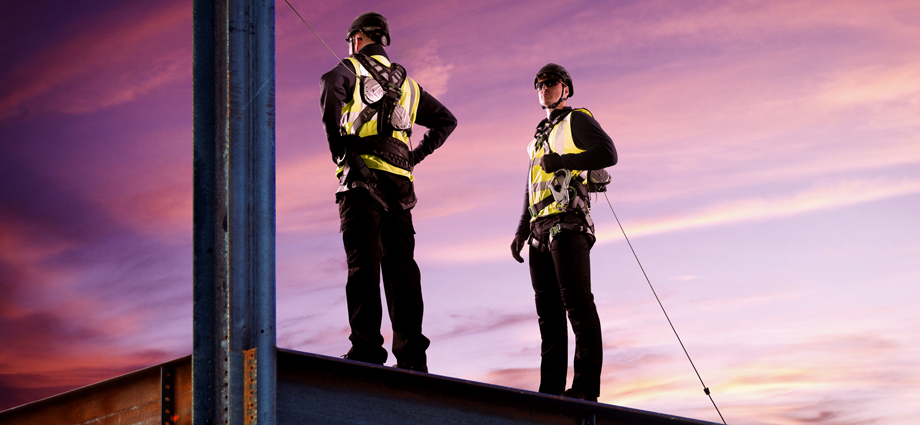
In this article, Tim Bissett, Technical Manager for Fall Protection at MSA Safety looks at the relevant standards relating to leading edge work; what to look out for in the equipment you use; and what processes you need to have in place, including the vital importance of a rescue plan.
Tim has been Technical Manager for the Latchways® Engineered Systems rangefor 18 years. Part of his role is to contribute to the development of product standards for PPE. This involves looking at product testing methods and systems and evolving standards to meet changingindustry needs. He is a member of the BSI Technical Committee PH/5, from which he convenes two working groups for CEN/TC 160.
“Leading edge” work or “edge working” is defined as working at any unprotected edge of a platform, floor, or other construction point where there’s a risk that the lifeline a worker is using may come in contact with an exposed edge, or edge of the working surface. In many scenarios, leading edge applications occur when a worker is connected to an anchor point below their back D-ring, although it’s also possible when anchor points are above this position.
Work in leading edge applications presents its own unique challenges and safety hazards; one of which is the greater risk of lifelines being frayed, cut, or severed on impact with the edge in the event of a fall. This is complicated further should the worker swing after falling, creating a pendulum-like motion. The friction this causes can increase the likelihood of the lifeline being cut or severed.
These potential risks place a sharp focus on testing criteria within relevant standards, following best practice and choosing the right equipment for the job. Let’s start by looking at the standards you need to be aware of.
First things first, before any leading edge work takes place, check that the equipment you’re using adheres to the relevant standards. We appreciate that these standards can seem complex, so we’ve broken them down below.
PPE Regulation (EU) 2016/425
Typically, fall protection is associated with saving a worker’s life in the event of a fall. And while this isn’t strictly wrong, it’s not the ideal scenario either. The hierarchy of fall protection helps to prevent a worker ever getting into a situation where they could fall by prioritizing various applications from “most preferred” to “least preferred”. Leading edge applications will inevitably mean working in fall arrest –the “least preferred” option. It’s not something to take lightly and should always be a last resort, taken only once the first three options outlined below have been explored.
Let’s take a look at some key things to consider if –after following this hierarchy –edge working remains the only option available.
First things first, all harnesses on the market should be compliant in accordance with EN 361:2002. That’s a given. But a good harness –one that’s comfortable, doesn’t restrict workers’ movement, and mitigates impact on the user’s body in the event of a fall –goes beyond mere compliance.
Fit is fundamental to achieving this. Leg and shoulder straps should be easily adjustable for a comfortable, snug fit. The user’s finished position in a fall scenario should be heads up and slightly forward-leaning. This is important for correct distribution of load through the leg straps and load through the body, such that the spine and pelvis are being properly supported and protected. In a fall event, a good quality, well-fitted harness can help limit the effects of suspension trauma/syncope (more on that later).
While incredibly important, fit is just one aspect. Fall protection harnesses are highly engineered pieces of kit and many design features dictate performance, such as appropriate materials for improved fit and speed of donning, or how dirt may affect the webbing (to name just a few). If in doubt about which harness is most appropriate for you and/or the job at hand then consult with a reputable manufacturer.
Making sure your workers have completed a comprehensive training programme is absolutely essential. Not only do employers have a responsibility to provide suitable information, instruction and training for their employees, but training gives those working at height the confidence, knowledge and skills required to carry out their work safely and efficiently. It will also teach operatives how to properly use, care and maintain their equipment.
For many, having followed the hierarchy of fall protection, edge working remains an unavoidable reality. If that’s the case then the steps you take before any work takes place are vital. So, stop, think and ask yourself these three questions:
Finally, remember, you don’t have to tackle all of this alone. Any reputable fall protection provider –like MSA Safety –is readily available for consultation on any of the above. They will be willing to help guide you on implementing the very best and safest work at height solutions. And at no other time is that more important than when working in leading edge applications.
Visit MSA Safety website to view MSA’sfull fall protection range, including training courses.